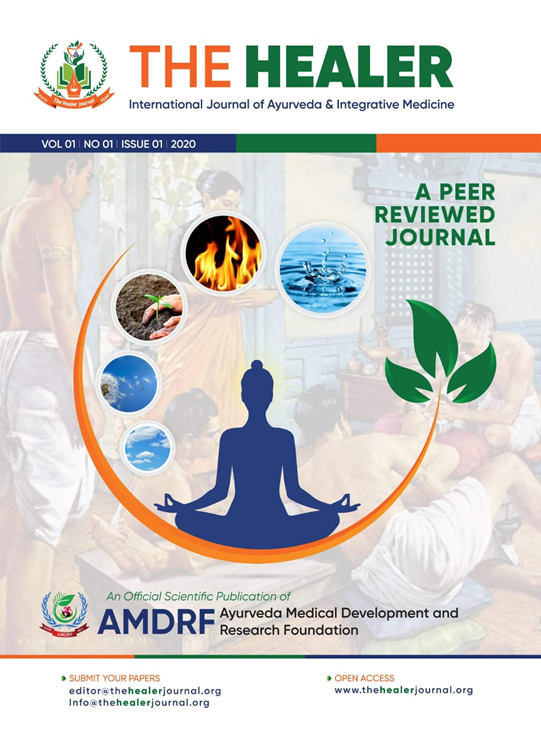‘The Healer’ – An International Biannual peer reviewed, open access scientific journal in Ayurveda and integrative Medicine is published biannually by Ayurveda Medical Development and Research Foundation (AMDRF) Kathmandu, Nepal. It publishes full-length original research papers, reviews, Short Communications, Letters to the Editors, Book reviews, Commentaries, case reports, case series, technical reports, Conference announcements and news. on Ayurveda and allied sciences related to traditional medical practices as well as integrative medicines. All articles published by The Healer are selected by an in-house editorial board and fully peer-reviewed by external reviewers. The published open access all articles will be immediately available for reading, downloading, copying and distributing free of cost to everyone. The full length papers of the journal is accessible on the website; www.thehealerjournal.org. The journal allows free access to its contents and permits authors to self-archive final accepted version of the articles on any Open Articles Initiative (OAI) -compliant institutional or subject-based repository. The journal does charge very minimal for submission, processing or publication of manuscript, and does not charge for editing, rearranging and colour reproduction of photographs. Started in 2020, the journal has continuously being contributed in the field of research, education and evidence based Ayurveda practices on the national as well as on the international platform.
Mission
Global propagation of Ayurveda and integrative Medicine through scientific evidences and education!
Vision
The Healer is aimed to aid the dissemination of important researches and theoretical works in different areas of common interest to the educators, researchers, specialized and general therapists of traditional medicines, which includes Ayurveda, Yoga and Naturopathy, Unani, Siddha, Homeopathy, Integrative Medicine, Biomedical Sciences, CAM, and other system of medicines in general and Clinical research, researches on Medicinal Plants or Herbs, minerals, animal by-products, Spices, and Pharmaceutical sciences in a particular.
Objectives
- To disseminate the knowledge and researches findings of Ayurveda among the world communities.
- To develop “The Healer” into a dynamic, vibrant and trustworthy publishers of high impact researches related to Ayurveda and Integrative medicines.
- To integrate recent advance technologies to explore Ayurveda treasures into evidence based.
- To attain global leadership in Ayurveda and integrative medicine researches for treatment and prevention of emerging important lifestyle-related disorders as well as communicable diseases.
- To carry out publishing up to date findings in Ayurveda and integrative medicines to promote health in the globe through Ayurveda. Advocacy for the to discouragement of industrially biased research. Have focussed discourses to bridge research results with clinical application.
Scope of the journal:
“The Healer Journal” publishes full-length original research papers, reviews, Short Communications, Letters to the Editors, Book reviews, Commentaries, case reports, case series, technical reports, Conference announcements and news on Ayurveda and allied disciplines including all forms of traditional as well as integrative medicines. The journal provides an interdisciplinary forum for all aspects of dissemination of research findings on drugs and procedures, reviews, case reports, case series, technical reports. The journal is devoted to publish original articles on the utilization of knowledge of Ayurveda and other traditional as well as integrative systems of medicines. The spectrum of coverage is broad encompassing all eight divisions of Ayurveda including clinical researches in Kayachikitsa (General medicine), Shalya Tantra (Surgery), Shalakya Tantra (ENT & Ophthalmology),Stri Roga Prasuti Tantra(Gynecology & Obstetrics), Kaumar Bhritya (Pediatrics); preclinical or Drug researches in Dravyaguna (Pharmacology) and Rasa Shastra & Bhaishajya Kalpana (Ayurvedic Pharmaceuticles); basic and literary researches in Maulika Siddhanta & Samhita (Basic Principles) along with History, descriptions of herbal remedies, useful for the treatment of human aliments etc. It also deals with clinical and pharmacological evaluation of herbs, minerals, metals and animal products, validation of food remedies, phytochemistry, ethnomedicine, survey of medicinal plants, pharmacogenomics, nutraceuticals, drug standardization, biotechnology, agriculture, horticulture, pharmacovigilance and others relating Ayurveda and traditional medicines. The Healer also accepts standard review articles based on basic principles of Ayurveda, newly introduced diseases with their updated scientific knowledge in contemporary sciences. The guidelines can also be downloaded from the journal website (http://www.thehealerjournal.org). The journal published in English and provides instant open access to its content on the principle that making research easily available to the public supports a greater global exchange of knowledge and brings higher impact.
The Editorial and Peer Review Process:
The article submitted for publication in “The Healer journal” first undergoes editorial review for scanning & assessment of standard of the article. The journal expects that one of the authors would be authorized to correspond with the Journal for all matters related to the manuscript. All manuscripts received are duly acknowledged. Manuscripts with insufficient originality, serious scientific or technical flaws, or lack of a significant message are rejected before proceeding for formal peer-review. Manuscripts that are unlikely to be of interest to the The Healer readers are also liable to be rejected at this stage itself. The editor decides whether to forward the article for peer review or to return the article to authors for modification to meet the Uniform standard requirements of manuscript submission in The Healer. The journal follows double blind peer review system. Based on the editor’s decision, the article is forwarded anonymously to two subject experts for decision. The adjudicatory comments (if any) and suggestions (acceptance/ rejection/ amendments in manuscript) received from reviewers are again referred anonymously to the corresponding author for necessary modifications. If required, the author is requested to provide a point by point response to reviewers’ comments and make the amendments in the article are to be highlighted separately and then submit a revised version of the manuscript. The Editorial Board again examines the modified article and conveys the publication status of the article. The whole process of submission of the manuscript to final decision and sending and receiving proofs is completed online. To achieve faster and greater dissemination of knowledge and information, the journal publishes articles online as ‘Ahead of Print’ immediately on acceptance. During the process of publication, the editorial office sends proofs to authors for checking which is to be returned within three days after checking the setting, tables, figures etc. After publication, the Journal provides ten reprints and one author’s copy of the respective issue to the principal author.
Authorship Criteria:
Authorship credit should be based only on substantial contributions to each of the three components mentioned below:
- Concept and design of the study or acquisition of data or analysis and interpretation of data;
- Drafting the article or revising it critically for important intellectual content; and
- Final approval of the version to be published.
Participation solely in the acquisition of funding or the collection of data does not justify authorship. General supervision of the research group is not sufficient for authorship. Each contributor should have participated sufficiently in the work to take public responsibility for appropriate portions of the content of the manuscript. The order of naming the contributors should be based on the relative contribution of the contributor towards the study and writing the manuscript. Once submitted the order cannot be changed without written consent of all the contributors. The journal prescribes a maximum number of authors for manuscripts depending upon the type of manuscript, its scope and number of institutions involved (vide infra). The authors should provide a justification, if the number of authors exceeds these limits.
Conflicts of Interest/ Competing Interests:
All authors must disclose any and all conflicts of interest they may have with publication of the manuscript or an institution or product that is mentioned in the manuscript and/or is important to the outcome of the study presented. Authors should also disclose conflict of interest with products that compete with those mentioned in their manuscript.
Submission of Manuscripts:
All manuscripts must be submitted on-line through login the website www.thehealerjournal.org. First time users will have to register at this site. Registration is free but mandatory. Registered authors can submit the manuscript through email: manuscript@thehealerjournal.org and can keep track of their article after logging into the site using their user name and password. Authors do not have to pay for submission, processing or publication of articles. If you experience any problems, please contact the editorial office by e-mail at editor@thehealerjournal.org. The submitted manuscripts that are not as per the “Instructions to Authors” would be returned to the authors for technical correction, before they undergo editorial or peer-review. Generally, the manuscript should be submitted in the form of two separate files:
[1] Title Page/First Page File/covering letter:
This file should provide
(a) The type of manuscript (original article, case report, review article, Ethics Forum, Education Forum, Letter to editor, Images, etc.) title of the manuscript, running title, names of all authors/ contributors (with their highest academic degrees, designation and affiliations) and name(s) of department(s) and/ or institution(s) to which the work should be credited. All information which can reveal your identity should be here. Use text/rtf/doc files. Do not zip the files.
(b) The total number of pages, total number of photographs and word counts separately for abstract and for the text (excluding the references, tables and abstract), word counts for introduction + discussion in case of an original article;
(c) Source(s) of support in the form of grants, equipment, drugs, or all of these;
(d) Acknowledgement, if any. One or more statements should specify 1) contributions that need acknowledging but do not justify authorship, such as general support by a departmental chair; 2) acknowledgments of technical help; and 3) acknowledgments of financial and material support, which should specify the nature of the support. This should be included in the title page of the manuscript and not in the main article file.
(e) If the manuscript is presented as a part or whole at a meeting or conference or seminar, it should be mentioned including the organization, place, and exact date on which it was presented. A full statement about all submissions and previous reports should be sent to editor that might be regarded as redundant publication of the same or very similar work. Any such work should also be referred to specifically, and referenced in the new paper. Copies of such material should be included with the submitted paper, to help the editor decide how to handle the matter.
(f) Registration number in case of a clinical trial and where it is registered (name of the registry and its URL)
(g) Conflicts of Interest of each author/ contributor. A statement of financial or other relationships that might lead to a conflict of interest, if that information is not included in the manuscript itself or in an authors' form should be mentioned.
(h) Criteria for inclusion in the authors’/ contributors’ list.
(i) A statement that the manuscript has been read and approved by all the authors, that the requirements for authorship as stated earlier in this document have been met, and that each author believ













